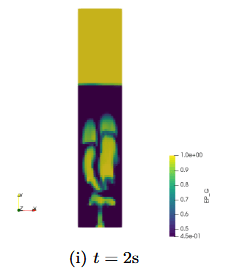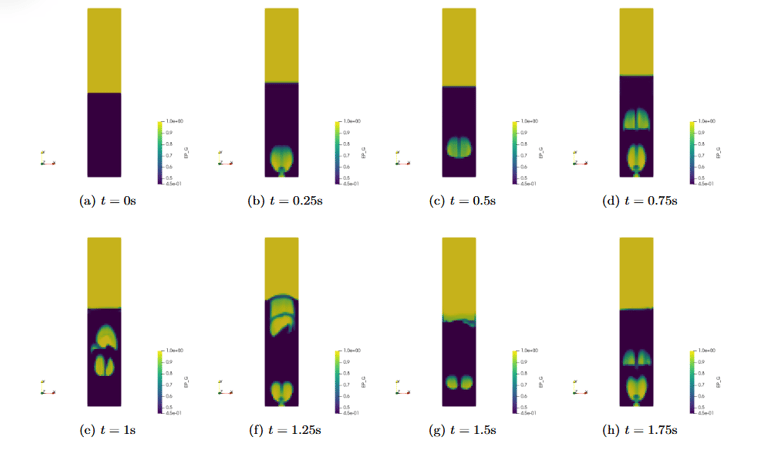Enhancing Gas-Solid Mixing in Pulsating Fluidized Beds Using CFD Simulation
Introduction
In the chemical process industry, fluidized bed reactors (FBRs) are critical to operations involving catalytic reactions, drying, combustion, pyrolysis, and gas-solid contact processes. Their popularity stems from excellent mixing, heat transfer, and scalability. However, performance challenges such as channeling, dead zones, and poor gas-solid contact can significantly affect product yield and energy efficiency.
To address these challenges, engineers are exploring pulsating gas inlets as a technique to enhance fluidization quality. This case study presents a detailed Computational Fluid Dynamics (CFD) simulation of a 2D fluidized bed operating under pulsating inlet conditions, using a two-fluid model (TFM). The focus is on understanding how dynamic flow rates influence bubble formation, void fraction, and overall bed behavior.
This project illustrates our advanced capabilities in transient multiphase CFD modeling, offering actionable insights for industries seeking to optimize fluid-solid reactors in energy, petrochemical, fertilizer, and pharmaceutical applications.
Objective
The primary goals of this simulation were to:
Replicate pulsating jet inlet behavior in a fluidized bed using a time-dependent boundary condition.
Evaluate the impact of velocity pulsation on bed hydrodynamics, void fraction distribution, and bubble dynamics.
Demonstrate a flexible digital approach using user-defined functions (UDFs) and keyframe data for real-time inlet velocity control.
Simulation Methodology
We modeled a 2D fluidized bed reactor with dimensions of 0.2 meters (width) and 1.0 meter (height). The lower half of the domain was initialized with granular particles, while a narrow gas inlet jet (0.04 m) at the center-bottom served as the source of pulsating airflow.
Key Features of the Simulation
Multiphase Flow Solver: Utilized a Two-Fluid Model (TFM) to simulate coupled gas-solid interaction.
Transient Jet Inlet: A stepwise velocity profile (between 0 m/s and 2 m/s every 0.25s) was prescribed using keyframe files.
Custom UDFs:
read_kf(ID) and interpolation routines allowed live velocity changes at each timestep.
set_bc0_vel_inflow() dynamically updated inlet boundary cells during runtime.
Mesh & Boundary Conditions:
Side walls: no-slip
Top: pressure outlet
Bottom: pulsating velocity inlet
Visualization Metric: Void fraction (εg\varepsilon_gεg) snapshots were used to evaluate bed structure and dynamics.
Results:-
Observations and Results
Bubble and Void Fraction Dynamics
Void fraction snapshots at various timesteps (from 0s to 2s) revealed:
Clear bubble generation and collapse consistent with the pulsation frequency.
Formation of coherent gas pathways during high-velocity periods.
Return to dense-packed bed states during zero-velocity phases.
Correlation with Pulsating Inlet Profile
The bubble patterns and gas expansion zones directly followed the keyframe inlet pattern. This proves the effectiveness of pulsating jets in creating controlled turbulence and enhanced bed fluidization.
Hydrodynamic Improvements Observed:
Better gas-solid contact compared to constant velocity inflow.
Enhanced mixing zone depth, improving the residence time distribution.
Reduced likelihood of dead zones or particle agglomeration.Conclusion
Why Pulsating Jets Matter in Industrial Reactors
Industries utilizing fluidized beds face trade-offs between energy efficiency and mixing quality. Pulsating gas flow can offer:
Reduced fluidization threshold
Improved thermal uniformity
Lower risk of bed defluidization
Greater control over particle entrainment and separation
This technique is especially useful in catalytic cracking units, fluidized dryers, gasifiers, and biomass conversion systems where uniform interaction between gas and solid phases is vital.
Applications and Industries Benefited
This CFD study supports optimization in:
🔬 Chemical reactors and process intensification
♻️ Waste-to-energy systems
⚗️ Catalytic and thermal cracking units
🌽 Biomass gasification and biochar reactors
🧪 Pharmaceutical granulation and coating beds
🏭 Powder drying, combustion, and calcination processes
Conclusion
This case study demonstrates our expertise in digital simulation of transient multiphase flows, specifically in fluidized beds using time-dependent inlet boundary conditions. With this pulsating bed CFD model, we helped visualize complex bed dynamics and identified process improvements that can be adapted to industrial-scale chemical reactors.
Our simulation tools allow rapid prototyping, performance prediction, and design optimization—reducing time to market and operational risk for industrial clients.




